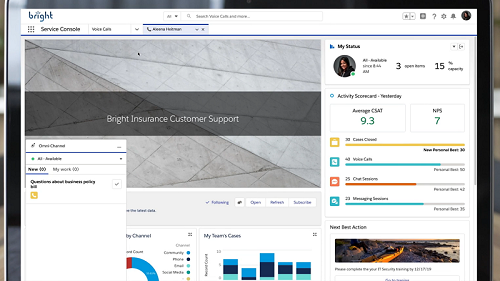Home > Columns > CRM Columns
Automation and IoT Trends for Customer Service in 2021

Presented By: Onilab
Image credit: Pexels
On the whole, AI, IoT, and automation are becoming more and
more essential for every company. The COVID-19 pandemic only fuels this
tendency. Since business processes and relationships with customers have
largely moved online, there is a growing need for cutting-edge solutions linked
with the former and the latter.
Amid the pandemic, people have got used to dealing only with
those who offer impeccable service. Without a doubt, consumers won’t settle for
less thereafter. This fact forces market players to apply a headless
commerce architecture for a website’s better performance, to reinforce
customer support, and optimize business processes.
A rapidly changing online landscape defines the tendencies
in customer service and support we’ll talk about below. Most of them are
interconnected as technologies merge to ensure seamless
customer experience and workflow. In this post, we’ll go over the five main
trends in customer service that are related to automation and IoT (Internet of
Things).
1. Omnichannel Approach
Communication today is as multifaceted as ever before, which
has dramatically affected how consumers interact with brands. In particular,
it’s totally normal to change channels while moving through the sales funnel.
According to a survey by Google,
46% of shoppers checked online whether a thing is in stock in an offline
shop. People can start shopping on social media, move to an online store, and
finally pick up an order in a physical store.
Then, perfect customer service implies at least the
following aspects:
- the quick response of a live agent/robot;
- quick resolution of any issue;
- the ability to switch channels without communication history
loss;
- a personalized approach based on the data about previous
purchases and other contacts;
- the ability to find information without talking to anybody.
Most companies pursue a multichannel strategy now. L.e.,
they offer many possible connection points but all of them exist separately and
don’t exchange data about customers.
However, the ultimate goal is to create a symbiosis of
offline and online channels. It’s called omnichannel. Without a doubt, this
approach will become dominant in the coming years. And here, automation will be
of a crucial role.
2. Advanced Customer Service Platforms
As of now, brands are still on the verge of a revolution
that will transform a multichannel approach into a genuine omnichannel one.
Omnichannel can be partly reached with the help of refined software such as
AI-powered CRMs (e.g., Salesforce or Microsoft Dynamics 365).
These solutions serve principal omnichannel aims:
- fast and efficient customer inquiries processing;
- saving all customer data in one place;
- giving access to this info to agents that are accountable
for various channels;
- tracking and analyzing the whole customer journey;
- providing truly personalized customer service/support.
Put simply, modern CRMs and customer platforms unite
channels and teams to come closer to seamless customer service. As the demand
in this sector only grows, IT companies develop more and more complex solutions
that leverage the capabilities of AI and IoT.

Screenshot taken from the newsletter from Salesforce
official website
3. Predictive Customer Service
The perspective of proactive interactions with clients
excites the minds of businesspeople around the globe. IoT is the main driver of
this trend. People equip their homes and themselves with more and more
connected devices: phones, bracelets, smart speakers, TVs, fridges, smart home
systems, and so forth.
There are three important directions of how IoT can improve
customer service:
- Track device issues. It would be perfect to know about a
smartwatch or TV breakage beforehand and take steps to prevent/fix a problem,
right? IoT makes it possible to find and draw a customer’s and agent’s
attention to some suspicious changes in the device’s health index.
- Resolve issues with less owner’s involvement. Some breakings
can be fixed even before a customer notices that a device began to work worse.
Further automation could allow ordering refills for your stuff (say, a printer
or coffee machine) without your participation.
- Collect and analyze the customer’s preferences through the
data from their devices.
With the proactive approach provided via IoT, the quality of
customer experience will achieve a completely new tier.
4. More Chatbots
This list wouldn’t be full without
robotic process automation (RPA) in customer support. AI-powered chatbots
gradually become a conventional means of communication between brands and
clients.
Basically, virtual assistants can handle the following
tasks:
- answer simple questions and FAQs;
- track orders;
- recommend products;
- solve some issues;
- run a number of operations;
- help with navigation;
- call for a live agent to deal with more specific and
difficult cases (see the screenshot below from Levi’s online store).
Screenshot taken from the newsletter from Levi’s official website
Chatbots are quite an effective way of workflow automation
as they operate 24/7 and partially substitute human assistants. Chatbots can be
embedded in your website and Facebook Messenger. The more options you have, the
more accurate and fast service your customers will gain.
5. Hyperautomation
Gartner proclaimed
hyperautomation one of the most prominent tech trends for 2021. This
phenomenon includes two primary currents:
- Various technologies (including cutting-edge ones like AI,
machine learning, RPA, IoT, and so on) are connected to become more effective;
- All possible business processes should be automated. This
allows achieving the required level of business efficiency and agility to stay
demanded on the market.
According to a recent survey, about
70% of employees are optimistic about new technologies involved in the
workflow. In fact, hyperautomation can simultaneously improve the quality of
work and analysis, reduce expenditures, and enhance customer service.
Wrapping Up
The future is automation. Businesses will invest in
automation and new technologies more actively in the coming years. Even some
shortcomings (like current software limitations or legal constraints regarding
data protection) won’t be obstacles to automation development in all branches
of the economy. Those who implement omnichannel strategy, leverage AI, and IoT
will win far more grateful clients.
About the Author
Kate Parish

Kate Parish is the chief marketing officer at Onilab with
over 8 years of experience in Digital Marketing in the sphere of eCommerce web
development. Kate always aspires to broaden her competency in line with
cutting-edge global trends. Her primary areas of professional interest include
SEO, branding, PPC, SMM, Magento PWA development, and online retail in general.